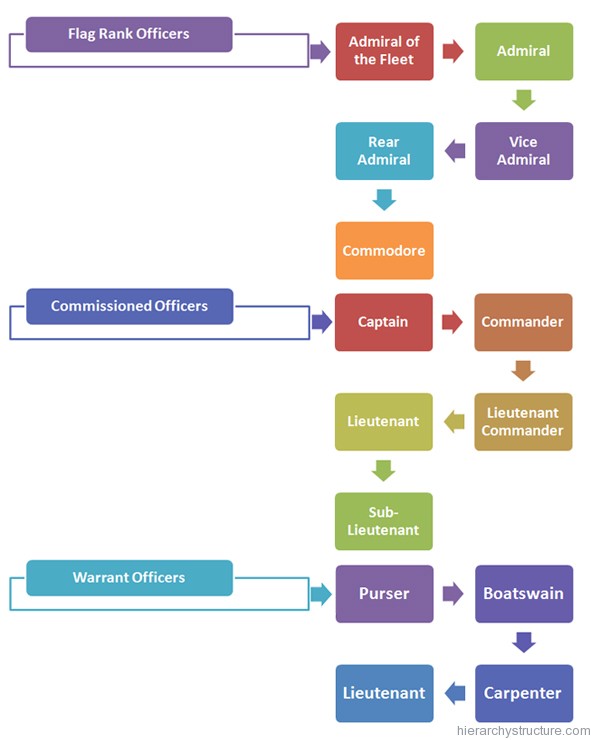The navy military hierarchy typically consists of four classes of officers known as Flag rank officers, Commissioned officers, Warrant Officers and Petty Officers. The flag rank officers consist of ranks such as Admiral of the Fleet, Admirals, Vice admirals, Rear admirals and Commodore.
The commissioned officers include Captain, Commander, Lieutenant commander, Lieutenant and Sub-Lieutenant. The warrant officers comprise of ranks such as Master, Surgeon, Purser, Boatswain, Carpenter and Gunner. And lastly the petty officers consist of Midshipmen, Chaplain and other petty officers.

Flag Rank Officers
- Admiral of the Fleet: This rank is also known as Fleet Admiral and is the highest rank in the Navy. This rank is equivalent to the General of the Royal Air Force and the General of the Army. The insignia of the Fleet Admiral is composed of five silver stars in a pentagonal shape.
- Admiral: The admiral rank is above the vice admiral and the below the Fleet Admiral. The insignia of the admiral is comprised of four stars.
- Vice Admiral: The Vice admiral ranks above the rear admiral and below the Admiral. The rank of Vice Admiral is equivalent to the rank of Lieutenant General in other uniformed services.
- Rear Admiral: The Rear Admiral is a position above the Commodore in a navy military hierarchy.
- Commodore: Commodore is a rank superior to a naval captain and below a rear admiral.
Commissioned Officers
- Captain: The Captain is the senior rank in the category of the commissioned officers. The rank lies above the commander and below the Commodore. The job roles of a captain are to prepare the ship for sailing, make inventories of the stores and to prepare the necessary reports. The captain is also responsible for directing the ship’s activities in naval engagements.
- Commander: A Navy commander in the military hierarchy is a senior position to a lieutenant commander and junior to that of a captain. The commander is perceived as equivalent to the lieutenant colonel rank of the army.
- Lieutenant Commander: This particular rank is subordinate to a commander and is superior to a lieutenant. A lieutenant commander acts as a senior departmental officer or an executive officer on a ship.
- Lieutenant: The lieutenant is superior to a sub-lieutenant. Previously, this particular rank was further classified as first lieutenant, second lieutenant and third lieutenant etc.. The first lieutenant also known as senior lieutenant, was afterwards transformed into the rank of commander. The lieutenants ensure that the crew carries out their job in the proper manner.
- Sub-Lieutenant: The sub-lieutenant is a subordinate rank to the lieutenants and is superior to the warrant officers.
Warrant Officers
The warrant officers are the heads of specific technical branches of the ship and perform different jobs, based on the profile. The Master is the senior warrant officer rank. Their main duty is navigation and analyzing the ship’s position on a regular basis. The surgeons were responsible for conducting the surgical operations, as necessary. The other ranks included in the warrant officers are Purser, Boatswain, Carpenter and Gunner.
